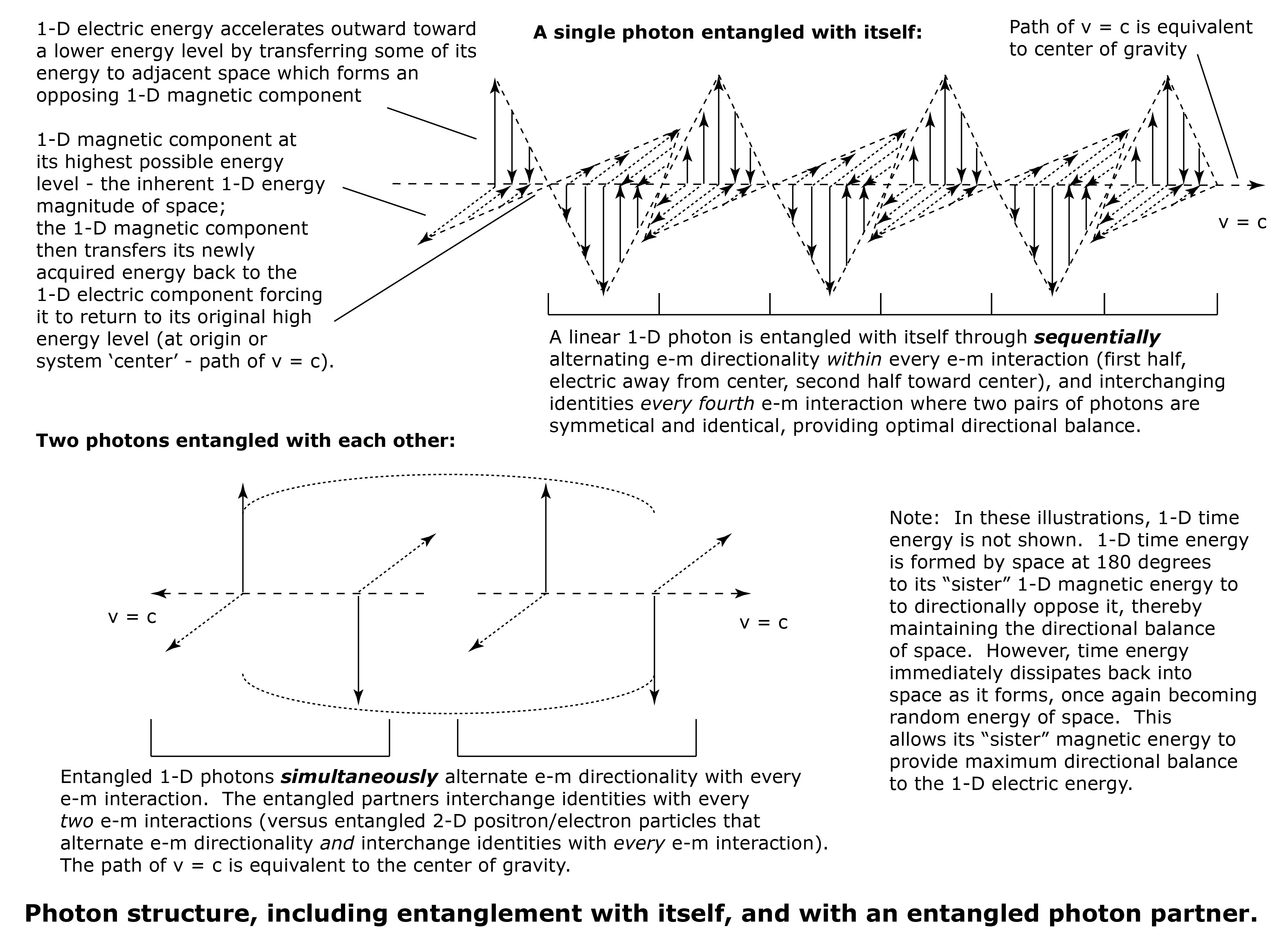 Photons consist of 1-D electric energy moving toward a lower energy level by transferring some of its energy to the energy of adjacent space. The rate of this transfer of energy toward a lower energy level is proportional to the total energy of the photon, and represents the ‘amplitude’ of the e-m wave.
Photons consist of 1-D electric energy moving toward a lower energy level by transferring some of its energy to the energy of adjacent space. The rate of this transfer of energy toward a lower energy level is proportional to the total energy of the photon, and represents the ‘amplitude’ of the e-m wave.
The inherent energy of space responds by forming opposing 1-D magnetic energy (with the energy transferred from the 1-D electric energy) perpendicular to the 1-D electric energy to provide maximum directional balance.
When the 1-D magnetic energy reaches its maximum energy level – the inherent 1-D energy magnitude of space – it can proceed no further, and then transfers its newly acquired energy back to the 1-D electric energy, forcing it to return to its original higher energy level. The process then repeats itself, so that when electric energy is at its highest energy level, magnetic energy is at its lowest energy level, and vice versa.
Although a photon may become entangled with an equal and directionally opposing photon, an individual photon is entangled with itself, ‘sequentially’ (as opposed to ‘simultaneously’ for 1-D photon pairs or 2-D particle pairs) alternating e-m directionality within each e-m interaction. The first half of an e-m interaction of a 1-D photon consists of the 1-D electric energy moving away from origin (or system center = path of v = c), with the second half consisting of the 1-D electric energy moving to origin or system center. This change in e-m directionality and subsequent entanglement within one e-m interaction provides optimal directional balance. Entanglement will be discussed in more detail later.
Keep in mind that even though we observe an e-m wave traveling at v = c, a photon is not actually in ‘motion’ relative to itself. A photon ‘perceives’ itself as a standing energy system that moves to and from lower to higher energy levels relative to origin or system center (i.e., path of v = c). Every successive e-m interaction essentially forms a new photon. And every successive new photon is identical to the previous photon, but forms at 180 degrees from the previous photon. Together, the two successive photons result in optimal directional balance for the 1-D electromagnetic energy (see illustration below).
Entanglement helps to maintain the directional balance of an energy system. For two photons formed by the same source at the same time, but moving at v = c in opposing directions, the two 1-D e-m energy systems will be entangled. But unlike a single 1-D e-m energy system, the two separate 1-D photons may be entangled simultaneouly with every e-m interaction. And the 1-D photons may possess both symmetry and interchange identities once every two e-m interactions (since the two separate 1-D e-m energy systems consist of simultaneous e-m interactions) (see illustration below).
The differential, or ratio, between the inherent properties of electric energy and those of magnetic energy = c, so that the electromagnetic energy system moves “sideways” or perpendicular to the electromagnetic interactions at a rate of v = c. The path of v = c is analogous to the center of gravity for 2-D and 3-D elementary electromagnetic energy systems.

1-D Photon Transforming to a 2-D Electron-Positron Pair
A 1-D photon with enough energy may transform into a 2-D electron-positron pair. The resulting electron and positron will be entangled, and instead of moving at v = c, they will each possess a 2-D gravitational energy gradient and a corresponding angular momentum of spin 1/2 in quantum terms.
Each of the two 2-D entangled particles exchange or alternate e-m directionality with every e-m interaction. In other words, with an e-m interaction, the electron becomes a positron, and the positron becomes an electron, and vice versa. The two 2-D particles interchange identities with every e-m interaction resulting in optimal directional balance. A 2-D particle that currently possesses electron e-m directionality is designated as e-+ since it is currently a negative particle and with the next e-m interaction will become a positive particle. In the same way, a 2-D particle that currently possesses positron e-m directionality is designated as e+-.
